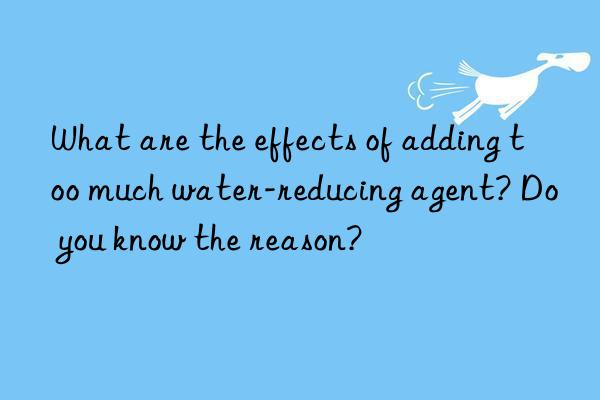
The purpose of adding water reducing agent is to reduce water consumption and improve concrete strength when making concrete, and also to save cement consumption. However, the amount of water-reducing agent added is sometimes not controlled well. If you add less, you can continue to add it. But what will be the impact if you add too much water-reducing agent? Many people don't understand it.
1. Add water and stir when no water-reducing agent is added. The cement slurry forms a flocculation structure, so that 10% to 30% of the mixing water is wrapped in the cement particles and cannot participate in free flow and lubrication. Water reducing agent is designed to solve this problem.
2. However, when the water-reducing agent is added too much, different effects will occur depending on the type of water-reducing agent. For example, if the water-reducing agent only has the function of reducing water, excessive amounts will cause excessive concrete slump, segregation, bleeding, hardening, etc.
3. If the amount of water-reducing agent with other functions such as retarding and air-entraining is exceeded, the setting will be excessively retarded and the air content will be too high, causing the concrete to set too slowly. The high air content will lead to a reduction in the strength of the concrete. Wait for the situation to arise.
What impact does water-reducing admixture have on the performance of fresh concrete? The materials that have not yet solidified and hardened are called Concrete mixture, also known as fresh concrete or concrete mix. The influence of water reducing agent on the performance of fresh concrete can be summarized as the following points: Workability improvement Workability is a comprehensive measure of the ease of construction operations (mixing, transportation, pouring, tamping) of concrete mixtures. Technical properties, including flow, cohesion and water retention.
Fluidity refers to the ability of the concrete mixture to flow and fill the formwork evenly and densely under the action of its own weight or the vibration force of construction machinery. Commonly used to express slump. A concrete mixture with a slump of zero is called dry hard concrete, a slump of 1 to 3 cm is called low plasticity concrete, a slump of 5 to 8 cm is called plastic concrete, and a slump of more than 10 cm is called large concrete. Slump concrete; a concrete with a slump of about 20cm is called fluid concrete.
After applying water-reducing agent, the slump of plastic concrete can be increased by 5~15cm while keeping the cement dosage and water-cement ratio unchanged; high-efficiency water-reducing agent can increase the slump at 2~3cm low plasticity concrete becomes fluid concrete with a slump of about 20cm. Cohesion refers to the ability of the concrete mixture to maintain overall uniformity during transportation and construction.
The cohesion of concrete mixtures mixed with water-reducing admixtures is significantly improved and is not easy to separate and layer. Water retention is often expressed as bleeding rate. Concrete with poor water retention is easy to segregate and bleed severely after pouring, causing the water content of the surface concrete to increase, producing a large amount of floating slurry, reducing the strength of the surface layer, easily cracking and powdering, and damaging the bonding between the pouring layers during layered pouring.
Regarding the impact of adding too much water-reducing agent, I will share it here. The bottom-grabbing phenomenon, lack of cohesiveness, long condensation time, etc. will affect the construction and even lead to substandard safety, so The amount of water reducing agent should be controlled. Within the error, if the error sometimes appears to be about 1.5 times, it will not be a big problem, but the error should still be reduced as much as possible.
</p

 微信扫一扫打赏
微信扫一扫打赏

